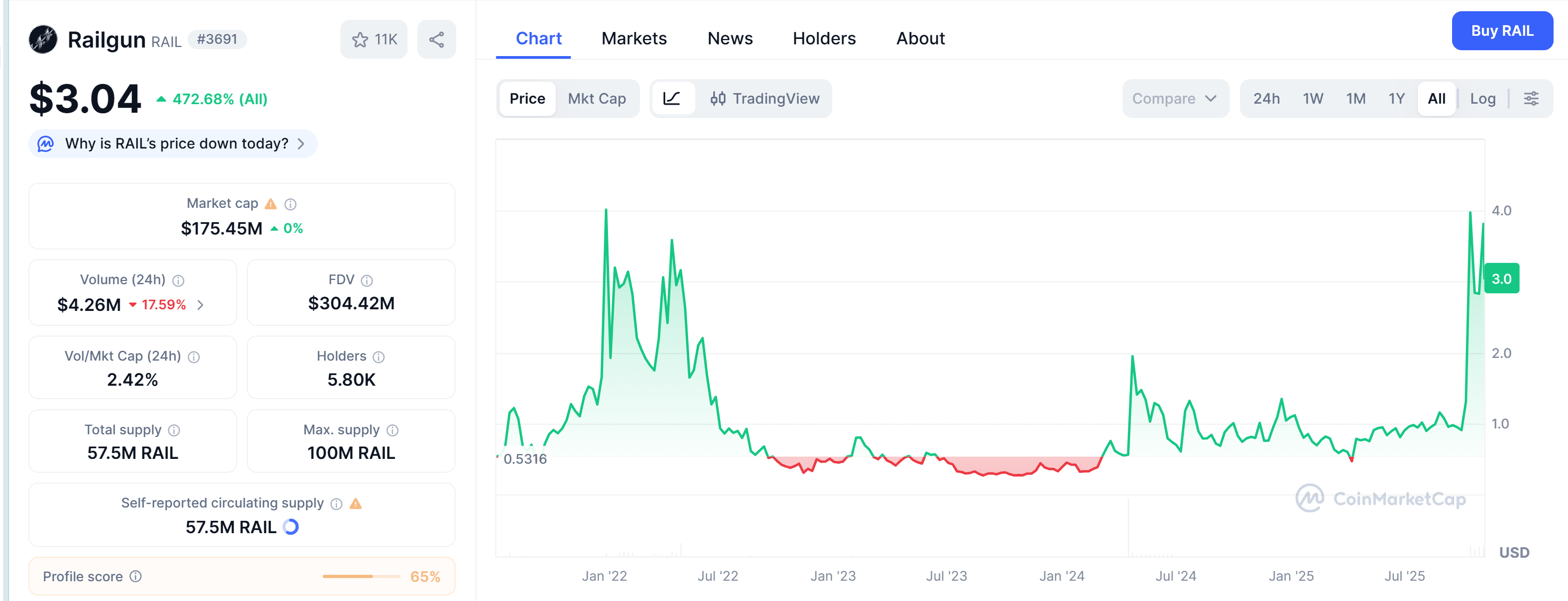Old projects, new attention
Due to the recent crazy surge of $ZEC , I revisited some privacy projects that the Ethereum Foundation and Vitalik Buterin are interested in. Some obscure projects that seem to have never been seen on social media have started to appear, so I took some time to learn about them.

RAILGUN is a fully on-chain, account-based, composable privacy system: it isolates funds and activities into a 'shielded pool' through zk-SNARK proofs, allowing direct interaction with DeFi protocols without exposing associations; while retaining 'optional disclosure (Viewing Key) and proof of innocence (Proof of Innocence)' to meet compliance audits.
Public chains expose all accounts and paths, and many everyday operations do not need to be 'visible to the entire network'.
The goal of RAILGUN is to achieve default privacy on-chain while retaining verifiable disclosure capabilities.
What is meant by 'usable on-chain privacy'
To determine whether a privacy system is 'usable', at least three factors should be considered:
Account-level privacy: sources, destinations, and account associations are not visible externally.
Composable: privacy can be invoked seamlessly in AMM, lending, derivatives, and other DeFi applications.
Optional disclosure: can prove to auditors/partners on demand that 'this money is clean' or 'this account is verifiable'.
RAILGUN is designed around these three points: Shielded Pool + Adapt privacy composite calls + Viewing Key/PoI (optional disclosure/Proof of Innocence).
Why previous generations of solutions are insufficient
Mixers are the simplest and most straightforward method: after a one-time obfuscation, exiting the pool exposes the transaction, making it unsustainable and non-composable.
The concept is complete, but scalability is challenging in terms of performance, experience, and compliance communication.
Privacy Rollups or private chains are the favored direction in most narratives: but in reality, migration/bridging and operational costs are high, and integration with mainstream DeFi is not smooth.
The goal of RAILGUN is very clear:
Summarized into three points:
Invisible irrelevant information, regular use of DeFi, verifiable when needed.
Implementation method
The first step is to change the accounting method.
RAILGUN places assets in a 'shielded pool', not stored in the form of traditional account balances, but recorded as encrypted UTXOs in a Merkle tree. The UTXO mechanism is inherently privacy-friendly, akin to cash and bank card transactions.
Externally, only state updates are visible; the correspondence between these records and the actual holders is not visible.
The second step is to prove the correctness of the transaction.
Each time assets are spent or external contracts are called, the system submits a zk-SNARK proof to demonstrate three things: ownership of these assets, no double spending, and that the transfer or contract call was indeed initiated.
On-chain, only the proof is validated and the state is updated; there is no need to know who is involved, where they come from, or where they are going.
The third step is to integrate privacy into composite calls.
The Adapt module of RAILGUN allows operations to be conducted directly from the shielded pool to protocols like AMM, lending, and derivatives, completing transactions in a single atomic transaction: 'out of pool → call → back to pool'.
No intermediate addresses are exposed during the process, nor will there be a traceable path left.
The fourth step is to reduce exposure at the network layer.
Through the Broadcaster/Relayer mechanism for transaction submission, relay accounts can send transaction packages on behalf of others, reducing the network fingerprint leakage of 'who is sending the packages'.
Finally, there is optional disclosure.
When it is necessary to prove the legitimacy of fund sources or assist in reconciliations, a Viewing Key (read-only key) can be generated to open the necessary accounts to specified parties; when it is necessary to prove 'not from a blacklist', a Proof of Innocence can be issued to meet compliance requirements without disclosing the true source.
Compared to traditional mixers, RAILGUN does not require immediate 'pool exit' after one-time obfuscation, supporting long-term holding and ongoing operations.
Compared to private chains or privacy rollups, working directly within the mainstream EVM ecosystem reduces migration, bridging, and operational costs.
Distinguished from centralized custodial privacy, relying on on-chain proofs rather than platform trust, users do not need to trust a specific operator.
Token RAIL
The governance token of the RAILGUN protocol is $RAIL, which was initially issued on the Ethereum mainnet in early 2021, with a total supply cap of 100 million.
Currently, transactions are primarily conducted on DEX.
The RAIL token is not a privacy coin and does not provide transaction anonymity; its main role is in decentralized governance.
In other words, setting aside the token, the railgun can operate independently, so the ability to capture token value is actually flawed.
RAILGUN is deployed on multiple chains, and governance also adopts a multi-chain autonomous model:
Each chain has its own governance token.
The token on the Ethereum mainnet is called RAIL (with a total supply of 100 million), while on BSC and Polygon it is mapped as RAILBSC and RAILPOLY (with supplies of approximately 44.54 million and 55 million, respectively).
RAILBSC and RAILPOLY are distributed to Ethereum RAIL token stakers and liquidity providers through community airdrops.
This means that supporters holding and locking RAIL on Ethereum received RAILBSC/RAILPOLY rewards at a 1:1 ratio when BSC and Polygon were launched.
The RAIL series tokens of each chain are only used for governing the deployment of RAILGUN contracts on their respective chains, such as parameter adjustments or upgrade proposals.
Cross-chain governance maintains consistency through a snapshot mechanism: for example, governance on the Polygon side requires referencing the snapshot of RAIL holdings on the Ethereum side to distribute voting rights.
